Carnivorous plants of Australia facts for kids
Australia is home to an amazing variety of carnivorous plants, with about 187 different kinds found across six main groups, called genera. These special plants have learned to catch and eat small insects and other tiny creatures. They do this to get extra nutrients that are missing from the poor soils where they grow.
Contents
Amazing Meat-Eating Plants of Australia
Carnivorous plants are super cool because they get their food in a unique way. Unlike most plants that just use sunlight, water, and soil nutrients, these plants have special traps. These traps help them catch insects, which they then digest to get important nutrients like nitrogen. Australia has a huge number of these fascinating plants, making it one of the best places in the world to find them!
What Are Carnivorous Plants?
Imagine a plant that can catch its own dinner! That's what carnivorous plants do. They usually live in places where the soil doesn't have many nutrients, like bogs or swamps. To survive, they've developed clever ways to trap small animals, mostly insects. Once an insect is caught, the plant uses special liquids, called enzymes, to break it down and absorb its nutrients. It's like a plant having its own digestive system!
Types of Carnivorous Plants in Australia
Australia is a hotspot for many different kinds of carnivorous plants. Here are some of the main groups you can find there:
Waterwheel Plants (Aldrovanda)
There is one type of Waterwheel Plant in Australia: Aldrovanda vesiculosa. These plants live in water and don't have roots. They float freely and have snap traps, much like a Venus flytrap. Their traps quickly close around small water insects or larvae.
Rainbow Plants (Byblis)
Australia has eight types of Byblis, and they are only found there. These plants are also known as "rainbow plants" because of the sticky, glistening drops on their leaves. These drops look like dew, but they are actually a strong glue that traps insects. Once an insect is stuck, the plant slowly digests it. Some examples include Byblis gigantea and Byblis lamellata.
Albany Pitcher Plant (Cephalotus)
Only one type of Cephalotus exists, and it's found only in Southwest Australia: Cephalotus follicularis. This plant is famous for its small, pitcher-shaped leaves. These "pitchers" are like tiny jugs filled with digestive liquid. Insects are attracted to the rim of the pitcher, slip inside, and can't climb out. The plant then digests them.
Sundews (Drosera)
Drosera, or sundews, are the most common type of carnivorous plant in Australia, with 117 different species! They get their name from the sparkling, sticky drops on their leaves, which look like morning dew. These sticky drops are actually glue traps that catch insects. Once an insect is caught, the leaf often slowly curls around it to help with digestion. Some Australian sundews include Drosera binata (the Forked Sundew) and Drosera gigantea (the Giant Sundew).
Tropical Pitcher Plants (Nepenthes)
Australia has four types of Nepenthes, which are tropical pitcher plants. These plants grow large, hanging pitchers that can be quite big. Like the Albany Pitcher Plant, these pitchers are filled with digestive fluid. Insects fall into the liquid and are digested. Nepenthes mirabilis is one example found in Australia.
Bladderworts (Utricularia)
There are 58 types of Utricularia, or bladderworts, in Australia. These plants are very special because they have tiny, underwater "bladders" that act like vacuum traps. When a small water creature touches a trigger hair on the bladder, the bladder quickly sucks in water and the creature in less than a second! This makes them one of the fastest trapping plants. Utricularia aurea is a common bladderwort.


